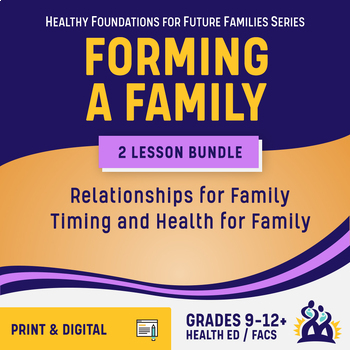Bundle - Life Skills: Forming a Family Unit - HS Health & FACS
- Zip
- Google Apps™

Products in this Bundle (2)
Bonus
Description
Just in time! You'll love these ready-to-use materials with current information on healthy relationships and the benefits of intentional, responsible choices about how and when they begin a family. Your students will enjoy learning as they create personal plans for their life goals and a strong future family. Key points are supported by a rich array of statistical data and scientific health information. Standards based, 144 Slides, 12 workbook pgs.
This unit includes these lessons from the Healthy Foundations for Future Families series:
- Relationships for Family (Lesson 4)
- Timing and Health for Family (Lesson 5), plus ...
- BONUS: Goals for Family (Lesson 3) has been included as a prelude to the other two lessons, in case you have not already purchased it. By providing time for students to envision their ultimate family and life goals, students’ interest and engagement in Lessons 4 and 5 will be enhanced.
Here’s why you’ll LOVE this Unit!
✅ No Prep!
✅ Fully engaging & inclusive across genders, cultures, faiths, family structures
✅ Great conversation starter questions
✅ Supports social-emotional learning (SEL)
✅ Utilizes Motivational Interviewing techniques
Aligns with National Standards (lesson meets all or a subset of listed standards)
✅ Common Core ELA – Language and Speaking & Listening grades 9-12
✅ FACS, Areas of Study: 6.0 Family, 12.0 Human Development, 15.0 Parenting
✅FACS, Areas of Study: 6.0 Family, 12.0 Human Development, 15.0 Parenting
What students and teachers are saying
⭐️ “I liked how educational and eye-opening it was.” Male Student (15)
⭐️ “I will start planning my future and make sure I’m ready before I have a kid.” Female Student (14)
⭐️ “This entire lesson is great!!! It's awesome and teaches everything I try to in a complete and holistic way. I truly love this lesson.” High School Educator
Lesson Materials
- Slides – Suitable for teacher-led or independent student learning
- Student Workbooks – PDF file with fillable fields and printable, also a Google file version
- Student Lesson Plans (1 page, editable PPT) - Overview of the lesson, editable for student instructions, due dates, links to slides and workbook files, etc.
- Curriculum Correlation to National Standards PDF
- Google Apps™ digital version of all materials linked on PPT Slides and Instructor Guides in the Zip file
- Instructor’s Guide – Provides presentation notes, activity ideas, expansion topics, and references
✏️ Students will do these activities
- Identify desirable characteristics of partners
- Evaluate benefits of a stable relationship for marriage, parenting, and a child’s wellbeing
- Consider the difficult choices posed by an unplanned pregnancy or separation from a co-parent
- Analyze personal needs and characteristics and their effects on interpersonal relationships
- Prepare a back-up plan in the event of an unplanned pregnancy
- Assess risks of alcohol, drugs, tobacco to fetal health during preconception and prenatal periods
- Identify the steps they and their partner will take to optimize health before and during a pregnancy
Students will learn
- A definition of healthy relationships and a schema for the spectrum of relationship behaviors
- How to recognize and address unhealthy or abusive relationships
- Absentee father statistics, single parenting statistics - historical trends and international comparisons
- Responsibilities of both partners in pregnancy planning and prevention
- The ways teen parenting can impact each family member – including % single parents and % who don’t finish high school
- U.S. rates of teen births - historical trends and international comparisons
- The increased risk of unplanned pregnancy with drug and alcohol use
- A definition of preconception health
- Stages of prenatal development
- The effects of alcohol and tobacco on pregnancy and fetal development, including Fetal Alcohol Spectrum Disorder
- Responsibilities of both partners in choosing the timing and optimizing health prior to pregnancy
Note: This unit’s focus is on motives, personal health, and decision-making. Because there is wide variance in school policies and community guidelines for sex education, this unit does NOT cover topics such as physiology of sex, STIs, or methods of pregnancy prevention. This unit DOES enjoy broad support from school administrators and parents.
HAVE QUESTIONS OR NEED ADVICE? Feel free to email me at rrubenstein@eduparents.org . I’m happy to assist you.
➕ Stay connected with Educate Tomorrow’s Parents!! Click the green Follow Me star beneath my store’s name (Educate Tomorrow’s Parents) to receive notices of free resources and new products.
More About This Resource
This unit is part of the Healthy Foundations for Future Families program. I created the Healthy Foundations program to empower teens to make healthy choices before they form families. The ultimate goals are to provide teens with the information and life skills to form strong families and prevent adverse childhood experiences for our next generation of children.
I have taught this program in a variety of high schools since 2005 and instructed over 9,000 students. After participating in this program, over 95% of students have said they will be better prepared to care a family!
Terms of Use
Copyright © Randi Rubenstein. All rights reserved by the author.
Each purchase is for single teacher use only, and should not be shared with others. The purchaser is granted permission to make duplicates for classroom use only, and you may post it on a password-protected student website for the use of only your students. Redistributing and selling are strictly prohibited. Posting this item (or any part thereof) on the Internet is prohibited unless it is on your school’s protected website. Violations are subject to penalties of the Digital Millennium Copyright Act.





